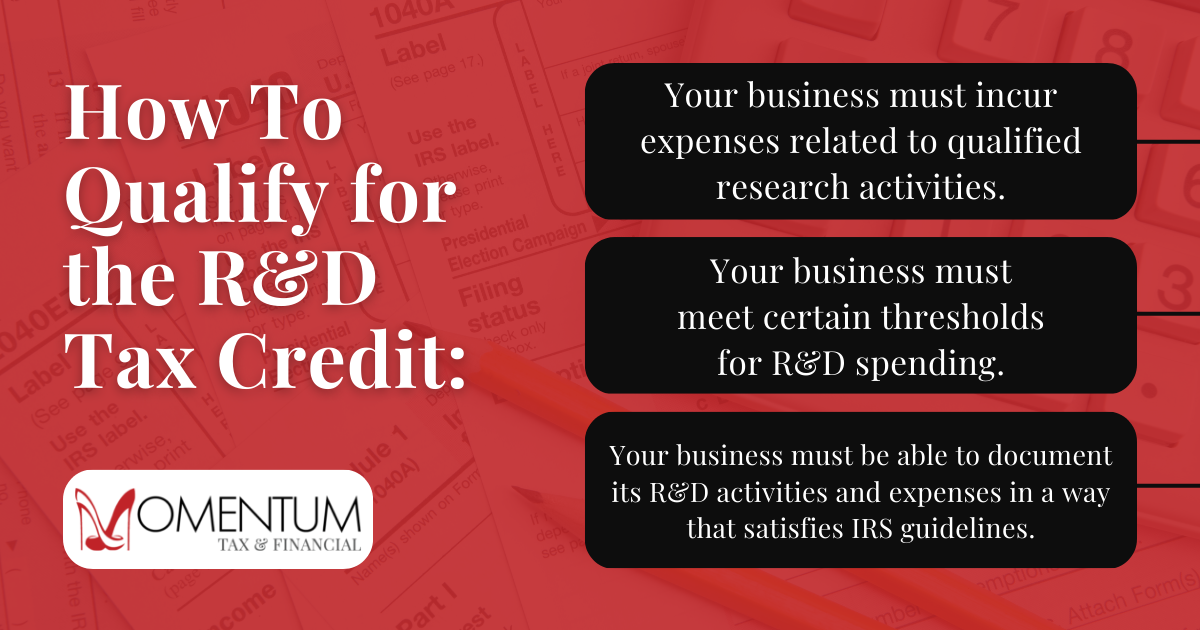As a business owner, you know how important it is to keep your expenses as low as possible while maximizing profits. One way to do this is by leveraging tax credits.
The Research and Development (R&D) Tax Credit is a federal incentive that allows businesses to receive a tax credit for certain expenses related to research and development activities. In this article, we’ll cover what you need to know before filing for the R&D Tax Credit for 2022.
What is the R&D Tax Credit 2022?
The R&D Tax Credit was created in 1981 to incentivize businesses to invest in research and development activities. The credit is designed to offset the costs of R&D activities and encourage innovation in various industries. The credit has been renewed and expanded several times since then, and in 2022 it remains a valuable tax incentive for businesses of all sizes.
How To Qualify for the R&D Tax Credit
To qualify for the R&D Tax Credit, you must meet several criteria.
First, it must incur expenses related to qualified research activities, including developing new or improved products, processes, or software. A wide range of industries may be eligible for R&D tax credits as long as they are engaged in qualifying research and development activities. Some common (but not exclusive) eligible industries include:
- Technology development
- Software development
- Manufacturing
- Pharmaceuticals
Second, the business must meet certain thresholds for R&D spending, which vary depending on the size of the business and its history of R&D activities.
For example, if a business has been in operation for less than four years, it must have had less than $5 million in gross receipts for each year of operation to qualify for the credit. If a business has been in operation for more than four years, it must have had less than $50 million in average gross receipts for the previous three years to qualify. This threshold determines the minimum amount of research and development expenses a business must incur in order to qualify for the credit.
In addition to meeting these thresholds, a business must have qualifying R&D expenses. These expenses include wages, supplies, and contract research costs directly related to qualifying R&D activities. The R&D activities must also meet certain criteria, such as being undertaken to develop a new or improved product or process and involve a process of experimentation or technological uncertainty.
It’s important to note that while the R&D Tax Credit is available to businesses of all sizes, smaller businesses may have an easier time meeting the spending thresholds and qualifying for the credit. In fact, the credit can be especially beneficial for start-ups and smaller businesses investing heavily in R&D activities as they seek to establish themselves and grow their business.
Third, the business must be able to document its R&D activities and expenses in a way that satisfies IRS guidelines.
Businesses can claim the R&D Tax Credit on their federal income tax returns using IRS Form 6765. The credit is calculated as a percentage of qualified research expenses, including wages, supplies, and contract research. The credit can be applied against the business’s tax liability, or, in certain cases, it can be refunded.
How is the Credit Delivered?
The R&D Tax Credit can be claimed against a business’s income tax liability, or in certain cases; it can be refunded.
For example, if a business has no tax liability, it can carry forward the credit for up to 20 years or elect to receive a refund of up to 10% of its qualified research expenses for the year.
The credit can offset various taxes, including income, alternative minimum, and payroll taxes.
Understanding the R&D Tax Credit is Tricky
While the R&D Tax Credit is an excellent way to reduce tax liability and increase profits, understanding the credit and how to qualify for it can be tricky.
Many businesses fail to take advantage of the credit simply because they don’t understand the requirements or realize they qualify. This is why working with a professional who can help you determine whether your business qualifies for the credit and how to maximize your benefits is important.
At Momentum Tax & Financial, we specialize in helping businesses leverage tax credits to maximize their profits. Our team of experts can help you determine whether your business qualifies for the R&D Tax Credit and how to maximize your benefits. We have extensive experience working with businesses in the professional services, real estate, and non-profit sectors, and we can help you navigate the complexities of the R&D Tax Credit.
Contact us today to learn more. We’ll happily answer your questions and provide the guidance you need to take advantage of this powerful incentive.


